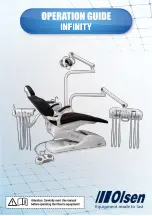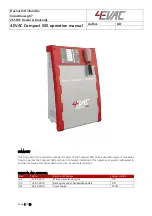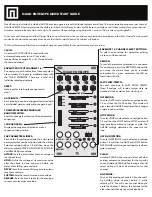
The following section is designed to give instructions on
the basic operations of this bench buffer.
CAUTION
To avoid kickback and other hazards, only buff on the
lower quarter of the wheel. Note the directional arrows on
the front of the bench buffer.
BASIC OPERATION
1. Make sure the ON/OFF switch is in the OFF position,
then plug in the tool.
Figure 5
On/Off
Switch
OPERATION
5
2. Place the ON/OFF switch in the ON position to turn on
the unit.
3. Using two hands, firmly hold the workpiece and gently
move it into contact with the buffing wheel.
4. Move the workpiece with the direction of the wheel,
using a medium to hard pressure.
NOTE:
The correct pressure must be applied to the
workpiece to provide the best finish. Too little pressure
will result in no significant change in the workpiece. Too
much pressure may slow down the action of the buffing
wheel and cause uneven marks on the workpiece.
5. Every few minutes, check the condition and wear of the
buffing wheels. Replace a buffing wheel when it is worn
or damaged.
6. When buffing is finished, remove the workpiece from the
buffing wheel before turning bench buffer OFF.
5
OPERATION
WARNING
Always place the ON/OFF switch in the OFF position
and unplug the power cord from its power source
before performing any assembly or adjustment.
Failure to do so could result in accidental starting resulting
in possible serious personal injury.
WARNING
To prevent serious injury from tool failure, do not use
damaged equipment. If abnormal noise or vibration
occurs, have the problem corrected before further use.
GENERAL MAINTENANCE
WARNING
Repairs to the bench buffer should be performed
by trained personnel only. Unauthorized repairs or
replacement with non-factory parts could cause serious
injury to the operator and damage to the bench buffer.
WARNING
If the supply cord of this power tool is damaged, have it
replaced by a qualified service technician.
MAINTENANCE
5
MAINTENANCE
5
Before each use, inspect the general condition of the tool.
Check for:
•
loose hardware,
•
misalignment or binding of moving parts,
•
cracked or broken parts,
•
damaged electrical wiring, and
•
any other condition that may affect its safe operation
CLEANING
After each use, wipe external surfaces of the tool with a
clean cloth.
Hand wash the buffing wheels using mild detergents, air
dry. If a buffing wheel has become too hard, use a stiff
wire brush (not included) to fluff it up.
Do not immerse any part of the tool in liquid.
WARNING
Periodically blow dirt and dust out of all air vents with
clean, dry air. To minimize the risk of eye injury, always
wear ANSI approved eye protection and NIOSH approve
breathing protection when performing this.
Содержание BF601
Страница 9: ...NOTE ...
Страница 10: ...6 HEAVY DUTY BENCH BUFFER PARTS ILLUSTRATION 8 PARTS LIST 8 ...
Страница 13: ...NOTE ...
Страница 14: ...NOTE ...
Страница 15: ...NOTE ...
Страница 16: ...Southern Technologies LLC 3816 Hawthron CT Waukegan IL 60087 ...


































